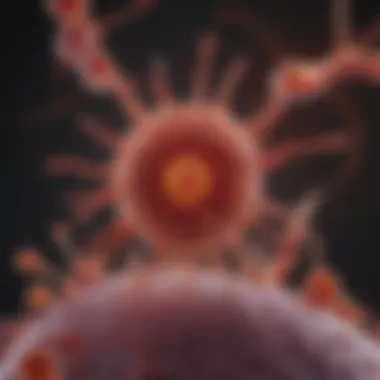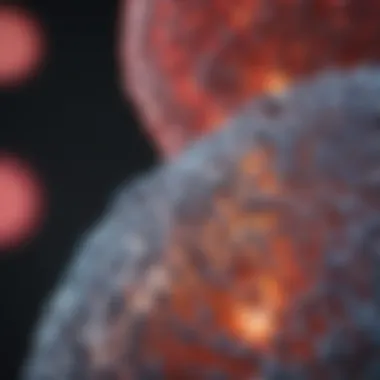Understanding RSV Immunity: Insights and Implications


Intro
Respiratory Syncytial Virus (RSV) is a predominant contributor to respiratory illnesses, affecting populations across ages. Yet, its impact is most pronounced in vulnerable groups such as infants and the elderly. Understanding the nuances of RSV immunity is crucial for informing vaccination strategies and public health efforts.
In analyzing RSV immunity, multiple factors come into play. This includes the effectiveness of natural immunity acquired post-infection and the role that vaccines play in offering protection. The complexity increases due to the virus’s ability to mutate and evade immune responses. Such characteristics render RSV a significant challenge in both clinical and public health contexts. This discourse aims to unravel these complexities while addressing critical insights and implications surrounding RSV immunity.
Key points of this article will include:
- The mechanisms involved in RSV immunity
- Factors influencing individual susceptibility
- The role of vaccines in combating RSV
- Public health implications derived from current research
In the following sections, each of these topics will be examined closely, providing a thorough overview of the current understanding of RSV immunity.
Prelude to RSV Immunity
Understanding immunity to Respiratory Syncytial Virus (RSV) is crucial for combating its impact on public health. RSV is a leading cause of respiratory illness in infants and elderly populations. The mechanisms of immunity, both natural and vaccine-induced, deeply influence how effectively individuals can resist this virus.
Identifying the nuances of RSV immunity can help healthcare professionals tailor prevention and treatment strategies. It also contributes to vaccine development, as only by understanding the immune response can we design effective immunization strategies. Improved knowledge means better management of the disease and informed public health policies that can lead to reduced morbidity and mortality associated with RSV infections.
In summary, this section lays the groundwork for a deeper exploration into both innate and adaptive immune responses, the challenges faced in developing vaccines, and how these insights can improve patient outcomes.
Overview of RSV
Respiratory Syncytial Virus (RSV) is a highly contagious virus that primarily affects the respiratory system. Characterized by its seasonal outbreaks, RSV is known to cause severe respiratory diseases like bronchiolitis and pneumonia, particularly in vulnerable groups.
The virus spreads easily through respiratory droplets and can survive on surfaces for several hours. Symptoms typically resemble those of a cold, including coughing, wheezing, and difficulty breathing. While most healthy adults may recover without serious issues, the risks escalate significantly for infants, particularly those less than six months old, and older adults with underlying health conditions.
Importance of Understanding Immunity
A thorough understanding of immunity to RSV presents several significant benefits. First, it sheds light on why certain populations are more susceptible to severe outcomes. For instance, infants have immature immune systems that may not respond adequately to RSV, leading to recurrent infections.
Additionally, comprehending the immune mechanisms can inform the design and efficacy of vaccines. It is important for vaccine developers to understand how the immune system recognizes RSV and mounts a response.
Research indicates that natural immunity tends to wane over time, enabling the possibility of reinfection. This creates a need for ongoing studies focused on long-lasting immunity, especially for vaccine development. Furthermore, the complexities of RSV immunity can influence clinical practices in high-risk populations by guiding management strategies.
"Understanding RSV immunity is not just a scientific pursuit; it's essential for health strategies that can save lives."
By focusing on both the innate and adaptive responses to RSV, researchers can work towards innovative solutions, ultimately enhancing public health measures worldwide.
The Immune Response to RSV
Understanding the immune response to Respiratory Syncytial Virus (RSV) is vital for addressing its impact on health. The virus poses specific challenges as it can evade immune defenses. This section explores two primary branches of the immune system involved: the innate and adaptive immune responses. Each plays a critical role in shaping how the body reacts to RSV infection.
Innate Immune Response
The innate immune response acts as the body's first line of defense against RSV. It provides a rapid response but lacks the specificity of adaptive immunity. Within this response, key players are macrophages and dendritic cells.
Role of Macrophages
Macrophages are essential in recognizing and neutralizing RSV upon entry. Their primary function is to engulf and destroy pathogens through phagocytosis. A remarkable feature of macrophages is their ability to release cytokines, which recruit other immune cells to the site of infection. This attribute makes macrophages a beneficial focus in RSV studies.
However, there are some disadvantages to consider. For example, while macrophages can help control the infection, they may also contribute to inflammation, leading to tissue damage. Understanding their dual role can inform better therapeutic strategies against RSV.


Activation of Dendritic Cells
Dendritic cells play a significant role in bridging the innate and adaptive immune responses. They are responsible for processing viral antigens and presenting them to T cells, thus activating adaptive immunity. A key trait of dendritic cells is their ability to capture and process invaders, ensuring effective immune activation. This characteristic is beneficial to the discussion of RSV, as it highlights mechanisms behind adaptive immunity.
Unique to dendritic cells is their capacity to migrate to lymph nodes, where they interact with T cells. This migration is advantageous in generating a robust immune response but can be a double-edged sword. If the activation is too strong or misdirected, it can lead to excessive inflammation and hinder recovery.
Adaptive Immune Response
The adaptive immune response is characterized by its specificity and long-lasting memory. This system becomes activated after the innate response and involves T cells and B cells.
T Cell Responses
T cells are crucial for controlling RSV. They recognize infected cells and can kill them directly, thus preventing the virus from spreading. A major aspect of T cell responses is their ability to differentiate into memory T cells, which provide long-term immunity. This characteristic makes them a focal point for developing vaccines that can elicit strong memory responses against RSV.
Nevertheless, there are challenges. The effectiveness of T cell responses can vary greatly among individuals, particularly in populations like infants and the elderly, who may experience diminished efficacy. Understanding this variability can lead to improved vaccination strategies.
B Cell Activation
B cells contribute to the immune defense through the production of antibodies. These antibodies can neutralize RSV and prevent reinfection. The key feature of B cells is their ability to recognize specific viral antigens, leading to targeted antibody production. This specificity is particularly useful when addressing RSV, as it highlights potential pathways for vaccine development.
However, B cell activation can be limited by several factors, including previous infections and genetic background. In some cases, B cell responses may not be robust enough, requiring further study to optimize vaccine formulations.
"Exploring both innate and adaptive responses reveals the complexities of how RSV interacts with the immune system. Understanding these interactions is essential for fighting this virus effectively."
After delving into the intricacies of the immune response to RSV, it is clear that both innate and adaptive mechanisms are paramount in shaping overall immunity. Each type of immune response contributes uniquely to the challenges presented by RSV, highlighting significant areas for further research and potential therapeutic interventions.
Factors Influencing RSV Immunity
Understanding the factors influencing RSV immunity is critical for developing effective interventions against Respiratory Syncytial Virus. Two primary themes emerge in this area: individual variances in immune response and broader public health implications. The immune system's complexity feeds into how different groups respond to RSV and how their susceptibility can vary widely. Furthermore, a comprehensive grasp of these factors can guide both clinical practice and policy formation, which are aimed at minimizing the impact of RSV, particularly in vulnerable populations such as infants and the elderly.
Age and Immune Protection
Age is a prominent determinant of immune protection against RSV. Neonates and young children often display a weaker immune response, leaving them more susceptible to severe RSV infections. For instance, maternal antibodies can provide some short-term protection, but this is gradually lost as the child ages. Conversely, older adults typically experience a decline in immune function, known as immunosenescence. This pathway makes them particularly at risk for severe RSV-related complications.
Research shows that older adults, especially those with underlying conditions, have a significantly greater incidence of hospitalization due to RSV. Offering protection strategies tailored to age groups can enhance overall immunity in these populations.
Genetic Factors
Genetic predisposition plays a key role in how both innate and adaptive immune responses function in relation to RSV. Variations in genes coding for immune response pathways can lead to disparate RSV susceptibility among individuals. Some genetic markers have been identified that correlate with an increased risk of severe infection. An understanding of these genetic factors enhances our ability to predict who may face a higher risk, thus enabling targeted preventive measures. Furthermore, the identification of these markers could revolutionize personalized medicine strategies in managing RSV infections.
Pre-existing Conditions
Pre-existing health conditions significantly affect an individual's immunity to RSV. Patients with conditions such as asthma or chronic obstructive pulmonary disease (COPD) often experience worsened symptoms when infected with RSV. In fact, certain heart or lung diseases can predispose individuals to severe outcomes. By managing these conditions effectively, healthcare providers may help bolster immunity against RSV. It is essential for healthcare systems to recognize and account for these underlying factors when developing community health strategies.
Understanding the interrelationship between pre-existing conditions and immunity can provide insights into better patient management and individualized care plans.
The factors influencing RSV immunity are multifaceted. Not only do we navigate the complexities of age, genetics, and pre-existing conditions, but we also recognize the vital importance of addressing immunity comprehensively. This enables public health initiatives to consider population vulnerabilities and design effective outreach strategies fitting for diverse demographics.
Vaccine Development for RSV
Vaccine development for Respiratory Syncytial Virus (RSV) is significant in the context of public health. Given the severe impacts of RSV on vulnerable populations like infants and the elderly, effective vaccination is crucial. Immunization can reduce the incidence of severe RSV infections, which can lead to hospitalization and, in some cases, death. Understanding the various strategies and technologies in vaccine design aids in creating more effective and safer vaccine candidates. Moreover, it helps in addressing public concerns regarding vaccine safety and efficacy. This section explores the historical development of RSV vaccines, current candidates in the pipeline, and the inherent challenges faced within this field.
Historical Context of RSV Vaccines


The pursuit of an effective RSV vaccine began several decades ago. Initial efforts, particularly in the 1960s, resulted in the development of a formalin-inactivated RSV vaccine. Unfortunately, this vaccine led to heightened illness upon natural infection, demonstrating the complexities involved in RSV immunology. Following this setback, research shifted focus toward safer and more effective formulations. Over the years, various platforms and methodologies have emerged, each attempting to achieve optimal safety and efficacy for different age groups while successfully eliciting an appropriate immune response. This historical context emphasizes the need for continuous research and adaptation in vaccine science.
Current Vaccine Candidates
Current vaccine candidates for RSV can be categorized into two primary types: live attenuated vaccines and subunit vaccines. Each type serves distinct purposes and is designed based on different scientific principles.
Live Attenuated Vaccines
Live attenuated vaccines are designed by modifying the virus to decrease its virulence. This approach allows the vaccine to mimic a natural infection, stimulating a robust immune response without causing the disease. A key characteristic of live attenuated vaccines is their ability to provoke long-lasting immunity. This is crucial for protecting against RSV, given that immunity from natural infection can wane over time.
However, there are challenges associated with this type. The risk of reversion to a virulent form is a concern, especially in immunocompromised individuals. Additionally, safety monitoring is essential, particularly in infant populations who are at higher risk from severe RSV disease. Nonetheless, live attenuated vaccines remain a popular choice, as they possess the unique feature of inducing both humoral and cellular immunity.
Subunit Vaccines
Subunit vaccines, on the other hand, utilize specific pieces of the virus, such as proteins, to elicit an immune response instead of the whole virus. This approach minimizes safety concerns associated with live virus vaccines. A key characteristic of subunit vaccines is their ability to be tailored for specific immune responses, making them potentially safer for all age groups, including infants.
Despite these advantages, subunit vaccines often require adjuvants to enhance the immune response, as they may not provide sufficient protection on their own. This reliance on adjuvants complicates the formulation and safety considerations. Still, their design can be a significant step towards effective vaccine strategies, especially in prioritizing safety for vulnerable populations.
Challenges in Vaccine Efficacy
The vaccine landscape for RSV is rife with challenges. One major hurdle is the variability of the immune responses generated by different populations. Infants and the elderly often have distinct immune profiles, making it difficult to create a one-size-fits-all solution. Furthermore, the potential for multiple strains and the ability of RSV to evade immune detection complicate vaccine development and efficacy.
In addition, financial and logistic issues hinder research and distribution efforts. Developing vaccines that can be deployed efficiently while maintaining manageable costs is vital for widespread deployment. Overall, addressing these challenges is crucial for advancing RSV vaccine development and ensuring effective immunization practices.
Natural Immunity to RSV
Understanding natural immunity to Respiratory Syncytial Virus (RSV) is vital for comprehending both the risks of infection and the way the immune system responds over time. Natural immunity typically arises after the body is exposed to the virus. It involves a complex interplay of the innate and adaptive immune responses that help protect individuals from subsequent infections. This section discusses the nuances of natural immunity, its duration and implications for public health.
Duration of Immunity Post-infection
After a person has recovered from an RSV infection, the question of how long immunity lasts becomes relevant. Studies indicate that natural immunity, while it may provide some protection, is not long-lasting. Antibody levels tend to decline significantly within a few months after infection. Individuals can experience reduced immunity, making them susceptible to reinfection.
The transient nature of this immunity poses challenges. It has been observed that reinfections can occur within a year or even a few months after the initial illness. Understanding this duration is crucial; healthcare professionals must weigh the benefits of natural immunity against the risks of recurrence.
"Natural immunity may not guarantee long-term protection against RSV."
Recurrent Infections
Recurrent infections with RSV are common, especially among young children. The phenomenon highlights that natural immunity does not completely shield individuals from reinfection. This raises concerns, particularly for vulnerable groups. Each new infection can potentially lead to increased severity, especially in infants or the elderly, where the immune response may not be as robust.
Recurrent infections indicate that while the body can mount an immune response, it may not be enough to prevent illness completely. This is evident in seasonal spikes in RSV infections during colder months, stressing the need for continuous observation and preventive strategies.
In summary, natural immunity to RSV is a critical topic that warrants further exploration. The insights gained can influence patient management and public health strategies. This not only underscores the necessity for effective vaccines but also highlights the importance of ongoing research to better understand how natural immunity functions in diverse populations.
The complexity surrounding RSV immunity necessitates a comprehensive view that incorporates both natural infection mechanisms and the subsequent immune responses.
Clinical Implications of RSV Immunity
Understanding the clinical implications of RSV immunity is essential, given the virus's significant threat to vulnerable populations. These implications have direct relevance to patient management and public health strategies. The intricate balance between natural immunity and the efficacy of vaccines informs treatment protocols and public health policies. The insights gained from studying RSV immunity guide healthcare professionals in making evidence-based decisions tailored to individual patient needs. In addition, understanding these implications helps in predicting epidemiological trends and preparing resources accordingly.
Patient Management Strategies


Effective patient management strategies for RSV cases hinge on a firm grasp of immunity dynamics. Health professionals need to prioritize individualized care based on the patient’s immune status, age, and pre-existing conditions. Here are some key considerations:
- Immunocompromised Patients: For patients with weakened immune systems, close monitoring for RSV symptoms is critical. Prophylactic measures, such as monoclonal antibodies like palivizumab, may be necessary to prevent severe RSV infections.
- Infants and Elderly: These populations are at higher risk for severe disease. Regular health checks can facilitate early detection and intervention, potentially avoiding serious complications.
- Education: Informing patients and their families about RSV can empower them to recognize symptoms early. This is particularly relevant during peak RSV seasons. Home care guidelines should be emphasized to ensure proper management at home.
Moreover, clinicians may consider antiviral therapies. Despite limited options currently available, ongoing research aims to identify more effective treatments, warranting continuous updates in management protocols.
Public Health Policies
Public health policies regarding RSV immunity should reflect an ongoing commitment to research and education. Significant aspects of these policies include:
- Vaccination Campaigns: Developing and promoting effective vaccines could drastically reduce the incidence of RSV. Public health initiatives must include education on the importance of vaccination, especially for high-risk groups.
- Surveillance Programs: Increased surveillance for RSV infections is vital to understanding the virus’s epidemiology and seasonal patterns. Data collected from these programs can inform strategic resource allocation.
- Antiviral Access: Policies should advocate for equitable access to antiviral treatments, particularly in under-resourced communities. Ensuring availability for those at highest risk remains critical.
- Cross-Collaboration: Engaging various stakeholders, including healthcare providers, researchers, and public health officials, can foster a collaborative approach to managing RSV effectively.
"Understanding the clinical implications of RSV immunity can inform both patient care and public health strategies, allowing for tailored interventions that save lives."
Overall, the clinical implications of RSV immunity play a pivotal role in guiding actions and policies that address the threats posed by this virus. Commitment to research and adherence to evolving strategies can reduce the burden of RSV, ultimately improving health outcomes in the most affected populations.
Future Directions in RSV Immunity Research
Understanding the future directions in RSV immunity research is crucial for improving public health outcomes. As our knowledge of Respiratory Syncytial Virus evolves, so does the potential for more effective intervention strategies. This section elucidates the importance of ongoing research, including emerging technologies and innovative approaches to vaccine development.
Emerging Research Techniques
Recent advances in scientific methodologies provide researchers with powerful tools to explore RSV immunity. Techniques such as next-generation sequencing (NGS) allow for comprehensive analysis of the viral genome and immune responses at the molecular level. This capability enables scientists to identify genetic variations of RSV and assess the implications for immunity and vaccine design.
Moreover, high-throughput screening methods can facilitate the identification of immune responses across diverse populations. Utilizing these techniques, studies can more accurately measure the efficacy of potential vaccines and natural immunity. Understanding the cellular and molecular interactions during infection could unveil new targets for therapeutic interventions.
Additionally, bioinformatics approaches contribute significantly to RSV research. By analyzing vast datasets, researchers can uncover patterns in immune responses, identify biomarkers for susceptibility, and predict vaccine efficacy. These insights are vital for tailoring future vaccine strategies to specific demographics.
"Advancements in research methodologies are vital in addressing the complexities of RSV immunity."
Prospects for Improved Vaccines
As the understanding of RSV immunity deepens, the prospect for developing improved vaccines expands. Current vaccines face challenges, including variability in immune responses based on age and pre-existing health conditions. This calls for the pursuit of novel approaches to optimize vaccine formulations.
- Live attenuated and subunit vaccines are under consideration. These approaches aim to enhance immunogenicity while minimizing potential adverse effects.
- mRNA technology, as demonstrated in recent COVID-19 vaccines, might also be adapted for RSV immunization. This method allows for rapid updates to the vaccine in response to emerging strains.
- Combining different vaccine modalities could yield synergistic effects, offering broader protection.
With ongoing research, the aim is to design vaccines capable of eliciting robust protective immunity across various populations. Tailoring vaccines based on individual immune profiles may lead to a more personalized approach in combating RSV.
The implications of these advancements in vaccine technology are significant for public health, promising better protection for infants, the elderly, and individuals with compromised immune systems. Addressing these factors will ultimately contribute to reducing the morbidity and mortality associated with RSV infections.
Ending
The conclusion of this article serves as a crucial element in consolidating the vast discussions on Respiratory Syncytial Virus (RSV) immunity. This section distills essential insights and offers a clear perspective on the complexities surrounding RSV's interaction with the immune system. It underscores the importance of a thorough understanding of both natural and vaccine-induced immunity, which is vital for informed decision-making in clinical and public health settings.
Summary of Key Points
A few key concepts have been explored throughout the article:
- RSV Overview: The nature of RSV, its modes of transmission, and its significant impact on vulnerable populations.
- Immune Responses: Differentiating between innate and adaptive immune responses, including the roles played by various immune cells.
- Influencing Factors: How factors such as age, genetics, and underlying health conditions affect immunity to RSV.
- Vaccine Development: Progress made in developing effective vaccines, the challenges faced, and the historical context of these efforts.
- Natural Immunity: The dynamics of immunity post-infection and recurrent infection patterns.
- Clinical and Public Health Implications: Strategies for managing RSV and individual and community health policies.
- Future Directions: Emerging research techniques and prospects for better vaccines.
These points reaffirm the duality of RSV immunity and how understanding this can improve treatment approaches and preventive strategies.
Implications for Future Research
The exploration of RSV immunity opens several avenues for future inquiry:
- Improved Vaccine Strategies: Innovative approaches are needed to enhance vaccine efficacy, particularly for high-risk populations. Ongoing research may focus on developing new vaccine formulations or combinations.
- Mechanistic Insights: Understanding how RSV evades immune responses on a molecular level could lead to breakthroughs in treatment and vaccine design.
- Long-term Immunity: Investigating the duration and effectiveness of both natural and vaccine-induced immunity will aid in formulating public health guidelines and vaccination schedules.
- Impact of Co-Infections: Research could delve into how other viral infections affect immunity to RSV, particularly in infants and elderly populations, which could change management strategies.
In essence, future research must focus on the intricate relationship between RSV and the immune system, aiming to adapt our responses to combat this persistent virus effectively.



